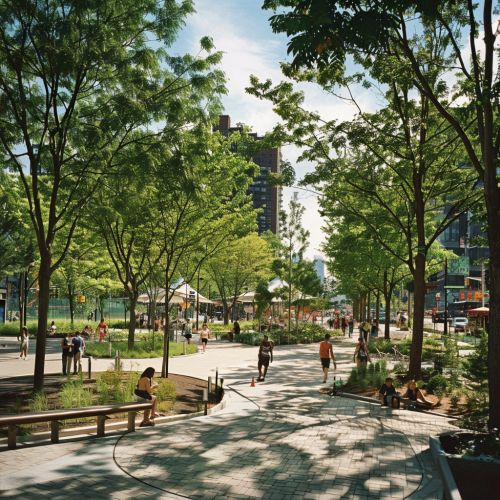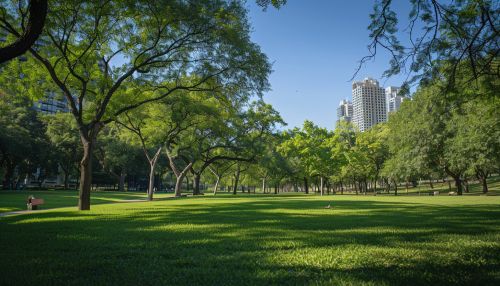Urban forestry: Difference between revisions
No edit summary |
No edit summary |
||
| Line 26: | Line 26: | ||
[[Category:Urban planning]] | [[Category:Urban planning]] | ||
[[Image:Detail-77811.jpg|thumb|center|A vibrant urban park filled with diverse tree species, providing shade and aesthetic appeal to the cityscape.]] | [[Image:Detail-77811.jpg|thumb|center|A vibrant urban park filled with diverse tree species, providing shade and aesthetic appeal to the cityscape.|class=only_on_mobile]] | ||
[[Image:Detail-77812.jpg|thumb|center|A vibrant urban park filled with diverse tree species, providing shade and aesthetic appeal to the cityscape.|class=only_on_desktop]] | |||
Latest revision as of 22:02, 7 May 2024
Introduction
Urban forestry is the management and care of tree populations in urban settings for the purpose of improving the urban environment. Urban forestry advocates the role of trees as a critical part of the urban infrastructure. Urban foresters plant and maintain trees, support appropriate tree and forest preservation, conduct research and promote the many benefits trees provide. Urban forestry is practiced by municipal and commercial arborists, municipal and county parks departments, environmental nonprofit organizations, community tree advocacy groups, and citizens who care about trees and the benefits they provide to communities.
History
The history of urban forestry can be traced back to ancient civilizations. The Egyptians, Greeks, and Romans recognized the aesthetic value of trees in urban environments and incorporated them into their city designs. However, the concept of urban forestry as we understand it today began to take shape in the late 19th century. In the United States, the profession of urban forestry began with the appointment of William Solotaroff as the first city forester in New Jersey in 1901. The field has since evolved to encompass a broad range of professional activities related to trees and forests in urban and urbanizing areas.
Benefits of Urban Forestry
Urban forestry provides numerous environmental, social, and economic benefits. These benefits, also known as ecosystem services, include air and water purification, reduction of stormwater runoff, conservation of energy through shading and windbreaks, reduction of noise pollution, and provision of habitat for wildlife. Trees also sequester carbon, helping to mitigate climate change. In addition to these environmental benefits, urban forests contribute to social well-being and community health. They provide aesthetic value, improve mental health, encourage physical activity, and even reduce crime rates. Economically, urban forests increase property values, attract businesses and tourism, and save municipal costs on stormwater management infrastructure.
Urban Forest Management
Urban forest management involves planning and implementing practices to maintain and enhance the health, diversity, and extent of the urban forest. This includes tree planting, pruning, pest and disease management, tree removal, and public education. Urban forest management plans are typically developed by urban foresters or arborists and implemented by a variety of stakeholders, including city departments, nonprofit organizations, businesses, and community members.
Challenges in Urban Forestry
Urban forestry faces numerous challenges, including limited growing space, poor soil quality, pollution, vandalism, and the impacts of climate change. In addition, urban forests are often subject to conflicting management goals and limited funding. Despite these challenges, urban forestry continues to be a vital component of sustainable urban development.
Future of Urban Forestry
The future of urban forestry lies in the recognition of trees as essential components of city infrastructure. This includes integrating trees into city planning and design, and investing in tree planting and maintenance as a way to improve environmental quality and human health. With the increasing recognition of the benefits of urban forests, there is a growing demand for professionals trained in urban forestry and related fields.
See Also


